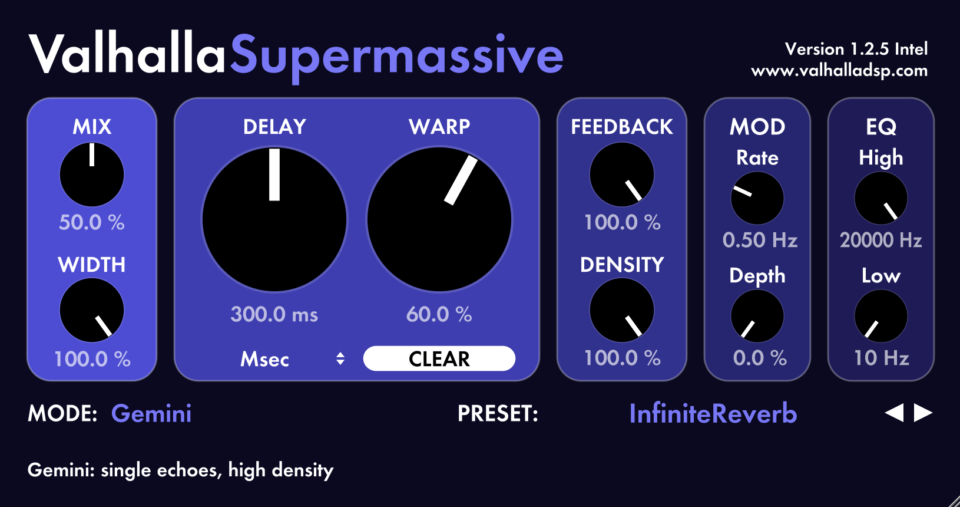Subtotal: $50 USD
Tips and Tricks: Infinite Supermassive
Today (May 19th, 2021) marks the one-year anniversary of the release of ValhallaSupermassive! To celebrate, I want to show you a quick and simple way of getting infinite or “freeze” reverbs out of Supermassive.
What’s an infinite reverb?
The idea behind infinite reverbs dates back to the early days of algorithmic reverberators. In your typical algorithmic reverb, you have a bunch of digital delay lines arranged in various series & parallel configurations. Feedback is applied to part of the network. The more feedback is applied, the longer the reverb time. When the feedback gain reaches 0 dB (i.e. a gain of 1.0), the reverb will theoretically go on forever, and you have an infinite reverb.
In reality, some reverb algorithms are better suited for truly infinite reverbs than others. In order to sound realistic, most reverbs have lowpass filters in their feedback loops, to create a more realistic decay. These lowpass filters can continue to filter away the high frequencies when the feedback gain is at 0 dB, which results in the “freeze” reverb becoming duller and more muted over several minutes. Reverb modulation can also cause a loss of high frequencies over time, depending on how it is implemented. The modulation can also cause the signal to turn into a cluster of sidebands, where the original pitch can no longer be perceived.
ValhallaSupermassive was designed to be a bright reverb from the get-go. It uses modulation with no filtering, and most of the algorithms have their low cut and high cut filters outside the feedback path. The filter location was chosen in order to emphasize some of the weird artifacts with low Warp settings, but it also makes these algorithms ideal for infinite reverbs!
Here’s how to infinite reverb in Supermassive:
- Start with an algorithm that can generate infinite reverb. This may not be obvious from the algorithm names, so here’s a quick list: Gemini, Hydra, Great Annihilator, Lyra, Capricorn.
- Set WARP to some non-zero setting, so that you get a reverb sound, versus a repeating echo.
- Set DENSITY to some non-zero setting, to smooth things out into reverb.
- Turn the Mod Depth to zero. This helps preserve the pitch of the freeze reverb.
- Finally, and most importantly, turn the FEEDBACK up to 100%.
Once you’ve done this, play a sound into Supermassive, and listen to that infinite decay!
Here’s an example freeze preset. Feel free to use this as your starting point, switching between the algorithms listed above, and adjusting WARP, DELAY, DENSITY, and the tone controls to your taste:

Supermassive Infinite Reverb Preset
Here’s the above preset in .vpreset format. To use this in Supermassive, select all the text (including the < and > tags at the beginning and end), select COPY (Cmd+C on Mac, CTRL+C on Windows), click on the name of the active preset in the Supermassive GUI, and select “Paste from clipboard.”
<ValhallaSupermassive pluginVersion="1.2.5" presetName="InfiniteReverb" Mix="0.5" DelaySync="0.25" DelayNote="0.2857142984867096" Delay_Ms="0.5" DelayWarp="0.6000000238418579" Clear="1.0" Feedback="1.0" Density="1.0" Width="1.0" LowCut="0.0" HighCut="1.0" ModRate="0.2738341093063354" ModDepth="0.0" Mode="0.0416666679084301" Reserved1="0.0" Reserved2="0.0" Reserved3="0.0" Reserved4="0.0"/>The infinite/freeze reverbs in Supermassive will have their own internal “motion” or beat patterns, depending on the algorithm used and the setting of DELAY. Larger delays will result in beat patterns that take longer to repeat.
If you want to add more motion to the sound, simply add the modulation/filtering plugin of your choice after Supermassive. In this example, I am running the Prophet-10 through Supermassive using the above InfiniteReverb preset. Halfway through the track, I fade in a slow stereo phaser (using the new PhaserDDL mode in ValhallaDelay):
Infinite reverbs are a cool trick, but they can be a powerful compositional element as well! Next week, I’ll show you how to use infinite reverbs from Supermassive as the building blocks for massive sounding pads.
 Valhalla UberMod
Valhalla UberMod 




These examples are really helpful. Thanks Sean.
Thank you so much for this ‘enless reverb’ tutorial. Is creates that great ‘Brian Eno’ sound!
I also appreciate your Shimmer video.